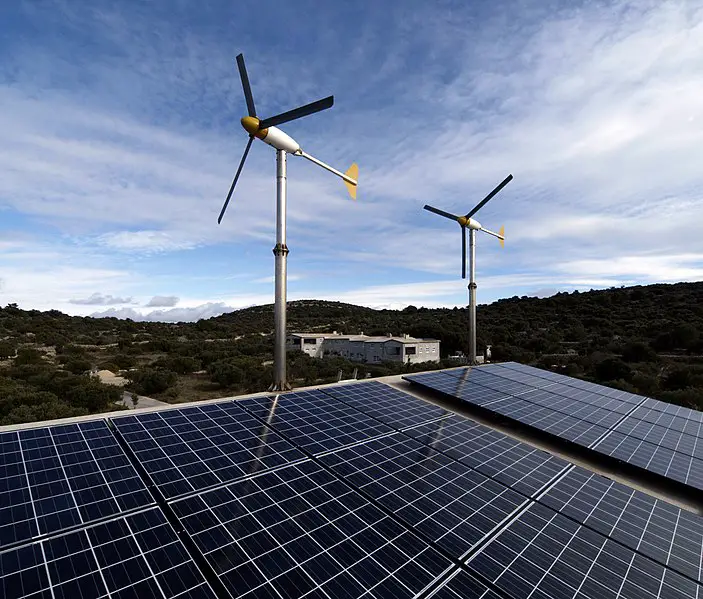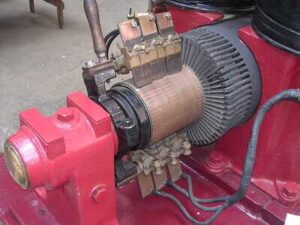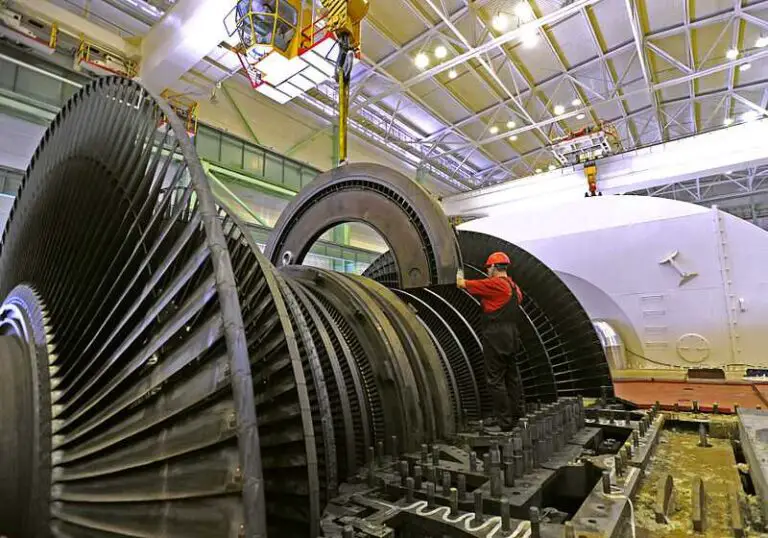5 Clean Energy Technologies and Their Basic Features Discussed
Clean energy technologies are; hybrid photovoltaic systems, bladeless wind turbines, nuclear breeder reactor, oscillating hydrofoil turbine, and flexible wave energy converter.
This article discusses clean energy technologies and their basic features, as follows;
1). Hybrid Photovoltaic Systems (as one of the Clean Energy Technologies)
Hybrid photovoltaic system is a clean energy technology that combines solar-capture and conversion components with other technologies for electricity generation, energy storage, or general energy management.
It is common to find hybrid PV systems that effectively combine solar energy capture, with other forms of renewable energy like wind and wave [7].
The design of any given hybrid system can vary significantly, and depends on specific factors like the energy components, functionality, scale, and intended use of the system.
Components of a hybrid PV system are; solar panels, meters, power inverters, energy converters, generators, turbines and cables.
Advantages of hybrid photovoltaic systems are; no greenhouse emissions, multiple energy options, space efficiency, and relative energy efficiency. These systems help maximize the output of solar panels while combining them with other useful technologies [5].
Hybrid PV systems are usable in both off-grid and grid-connected configurations, with microgrids, distributed energy resources management systems (DERMS), and as part of IoT networks.
The disadvantages of hybrid solar PV systems include their technical limitations as a relatively-new technology, as well as the possibility of output-reduction for each of the multiple components of such systems.

2). Bladeless Wind Turbines
As the name implies, a bladeless wind turbine is an an innovative clean energy concept involving wind turbines whose components do not include rotor blades.
In place of rotary mechanical dynamics, bladeless turbines use oscillatory (or vibrational) motion about a fixed position, to generate electricity.
The energy of vibration originates from kinetic wind energy, and causes a movable portion of the turbine tower or mast, to undergo harmonic motion about its fixed base. The mechanical energy from these oscillations is then used to activate an electromagnetic (in-built) generator.
Bladesless wind turbines are fairly effective, so that it is possible over 50% of the total output of a conventional turbine of equal height. The difference in effectiveness for bladed and bladeless turbines comes from a wider coverage for wind capture, that is achieved when blades are present.
However, when compared in terms of socioeconomic and environmental impacts, bladeless turbines present far more potential, as they occupy less space, cause less noise pollution, and are generally less expensive than conventional turbines [4].
The amount of energy produced by a bladeless turbine depends on specific design and scale, but generally ranges within hundreds of kilowatts at most [1]. Efforts to optimize wind energy technologies have also included power-capacity increment for bladeless turbines in recent years.
Benefits of bladeless turbines include; low-cost, simple design, small environmental footprint, and compatibility with other technologies like solar panels in a hybrid configuration.
3). Nuclear Breeder Reactor (as one of the Clean Energy Technologies)
Nuclear reactors produce clean energy by facilitating the fission (or fusion) of radioactive isotopes called nuclear fuels, in the reactor core.
The concept of breeder reactors represents an innovative, relatively-recent technology in the field of nuclear energy development.
Breeder reactors are not renewable energy systems, but they make nuclear energy to appear almost renewable, by recycling waste from spent fuel, and extracting stored energy that is further used by the system to generate electricity.
The main advantage of a breeder nuclear reactor is this ability to recycle and reuse nuclear waste as fuel for further energy extraction. Specifically, breeder reactors convert non-fissile uranium-238 isotope in spent fuel, to plutonium-239, which is fissile, through an artificially-driven radioactive decay process by bombardment of the U-238 isotopes with fast neutrons [2].
They are called breeder reactors for their ability to produce or 'breed' nuclear fuel from waste; which enables the reactor to run on minimal amounts of fuel for extended time periods.
Breeder reactors are highly efficient compared to conventional reactors, and can be used in nuclear power plants to achieve energy efficiencies that far exceed 45%. This is high, considering the many avenues of potential energy loss that exist in the complex process of nuclear power generation.

4). Oscillating Hydrofoil Turbine for Tidal Energy Conversion
Types of devices used in tidal energy capture and conversion include; vertical/horizontal axis conventional turbines, and oscillating hydrofoil turbines.
Oscillating hydrofoil is an innovative tidal energy technology that comprises of a movable component anchored on a fulcrum-style pivotal base that allows it to extract energy from the rise and fall of ocean tides, in the form of lift and drag forces on a hydrokinetic foil.
The foil is made to oscillate in a continuous upward-downward pattern by the gravitational impact of tidal forces, and the mechanical energy from this oscillation is used to generate electricity [6].
The oscillating hydrofoil turbine can be seen as a technological imitation of the propellant force-system that exists around aquatic organisms by reason of the upward and downward motion of their fins and tails [9].
It is a highly efficient concept compared to conventional tidal turbines, because of its relative simplicity, and energy-conversion rate.
5). Flexible Wave Energy Converter (as one of the Clean Energy Technologies)
Wave energy is clean energy that occurs in potential, kinetic and mechanical forms, in ocean waves.
Flexible wave energy converters are used to capture and convert wave energy to oscillatory mechanical energy that can activate a generator.
They may alternatively use electro-active materials like piezoelectrics that can directly convert mechanical energy from ocean waves to electricity as the device oscillates [3].
Flexible converters have some advantages over conventional wave converters, including fast deployment, simple and effective design, and relatively minimal cost [8].
Conclusion
Clean energy technologies include;
1. Hybrid Photovoltaic Systems
2. Bladeless Wind Turbines
3. Nuclear Breeder Reactor
4. Oscillating Hydrofoil Turbine for Tidal Energy Conversion
5. Flexible Wave Energy Converter
References
1). Ambrose, J. (2021). "Good vibrations: bladeless turbines could bring wind power to your home." Available at: https://www.theguardian.com/environment/2021/mar/16/good-vibrations-bladeless-turbines-could-bring-wind-power-to-your-home. (Accessed 24 March 2023).
2). Clifford, C. (2022). "The energy in nuclear waste could power the U.S. for 100 years, but the technology was never commercialized." Available at: https://www.cnbc.com/2022/06/02/nuclear-waste-us-could-power-the-us-for-100-years.html. (Accessed 24 March 2023).
3). Collins, I.; Hossain, M.; Masters, I. (2019). "A Review of Flexible Structures for Wave Energy Converters." European Wave Tidal and Energy Conference Series, Naples, Italy. Available at: https://www.researchgate.net/publication/336103434_A_Review_of_Flexible_Structures_for_Wave_Energy_Converters. (Accessed 24 March 2023).
4). El-Shahat, A. (2016). "Bladeless Wind Turbine as Wind Energy Possible Future Technology." Natural Gas & Electricity 33(4):16-20. Available at: https://doi.org/10.1002/gas.21942. (Accessed 24 March 2023).
5). Glover, E. (2022). "What Is A Hybrid Solar System, And Is It Worth It?" Available at: https://www.forbes.com/home-improvement/solar/what-is-a-hybrid-solar-system/. (Accessed 24 March 2023).
6). Kinsey, T.; Dumas, G. (2010). "Testing and Analysis of an Oscillating Hydrofoils Turbine Concept." ASME 2010 3rd Joint US-European Fluids Engineering Summer Meeting collocated with 8th International Conference on Nanochannels, Microchannels, and Minichannels. Available at: https://doi.org/10.1115/FEDSM-ICNMM2010-30869. (Accessed 24 March 2023).
7). López, M.; Rodriguez, N.; Iglesias, G. (2020). "Combined Floating Offshore Wind and Solar PV." Journal of Marine Science and Engineering 8(8):576. Available at: https://doi.org/10.3390/jmse8080576. (Accessed 24 March 2023).
8). Renzi, E.; Michele, S.; Zheng, S.; Jin, S.; Greaves, D. (2021). "Niche Applications and Flexible Devices for Wave Energy Conversion: A Review." Energies, MDPI, vol. 14(20), pages 1-25. Available at: https://ideas.repec.org/a/gam/jeners/v14y2021i20p6537-d654126.html. (Accessed 24 March 2023).
9). Xu, J-A.; Sun, H-Y. (2015). "Fluid dynamics analysis of passive oscillating hydrofoils for tidal current energy extracting." 2015 IEEE International Conference on Mechatronics and Automation (ICMA), Beijing, China, 2015, pp. 2017-2022. Available at: https://doi.org/10.1109/ICMA.2015.7237796. (Accessed 24 March 2023).


